 username@email.com
username@email.com
In this lesson you will classify and describe 2- and 3-dimensional figures, and identify parallel and perpendicular lines. You will use properties of these figures to construct proofs and draw conclusions about relationships among them.
The most basic geometric figure is a point. Because it has neither length nor width, it is 0-dimensional. In fact, every geometric figure is just a collection of points. You may recall that a line segment (usually just called a “segment”) is the set of all points on a line that lie between two points, called the endpoints. A collection of points extending forever in one direction from an endpoint is called a ray. Extend it in both directions and you get a line. A line segment has one dimension, length. Extend the line perpendicular to its length and you get a 2-dimensional plane. Extend the plane perpendicular to its surface and you get a 3-dimensional space.

An angle is formed by two rays that share an endpoint. The common endpoint is called the vertex of the angle. This is B. The interior and exterior of the angle are also labeled.
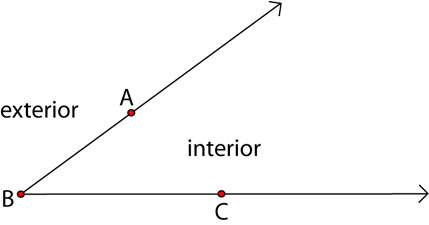
Angles are classified by their measures.
 |
An acute angle measures less than 90°. |
 |
A right angle measures 90°. The small square at the vertex of this angle indicates that the angle is a right angle. |
 |
An obtuse angle measures between 90° and 180°. |
 |
A straight angle is formed by two opposite rays. It measures 180°. |
If the sum of the measures of two angles is 90°, then the angles are complementary. If their sum is 180°, then the angles are supplementary.


What is the measure of the angle that is supplementary to ∠2 above?
The correct answer choice is C. Two angles are supplementary if the sum of their measures is 180°. So the angle that is supplementary to ∠2 measures 180°- 55°, or 125°. Choice A is incorrect. An angle that measures 35° is complementary to ∠2.
Recall that two lines are parallel if the distance between them is constant. That is, the distance stays the same. Also recall that perpendicular lines form right angles. There are marks in the figure below that show lines  and
and  are parallel. The right angle symbol shows lines
are parallel. The right angle symbol shows lines  and
and  are perpendicular.
are perpendicular.
What can you conclude about lines  and
and  ? If two lines are parallel, and one of these lines is perpendicular to a third line, then the other parallel line is also perpendicular to the third line. That means that
? If two lines are parallel, and one of these lines is perpendicular to a third line, then the other parallel line is also perpendicular to the third line. That means that  and
and  are perpendicular.
are perpendicular.
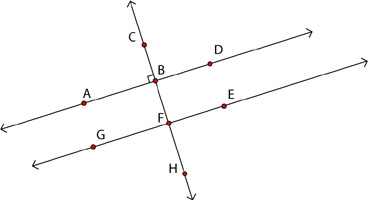
Vertical angles are congruent. That means that they have the same measure. We know that ∠ABC and ∠DBF are vertical angles, and ∠ABC is a right angle, so we can conclude that ∠DBF = 90°.
If m∠ABC = 40°, what is the measure of ∠BED?

The correct answer is C. Because m∠ABC = 40° and ∠ABC and ∠DBE are vertical angles, then m∠DBE = 40°. Because the sum of the measures of the angles in a triangle is 180°, then the measure of ∠BED is 180° – (40° + 90°), or 50°.

Given a line segment, how would you construct the midpoint and perpendicular bisector of that segment using a compass and a straight edge?
Follow these steps:
| 1. | Begin with line segment XY. |  |
| 2. | Place the compass at point X. Adjust the compass radius so that it is more than half of XY. Draw two arcs as shown here. | 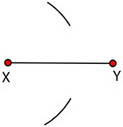 |
| 3. | Without changing the compass radius, place the compass on point Y. Draw two arcs intersecting the previously drawn arcs. Label the intersection points A and B. | 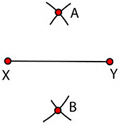 |
| 4. | Using the straight edge, draw line AB. Label the intersection point M. Point M is the midpoint of line segment XY, and line AB is perpendicular to line segment XY. | 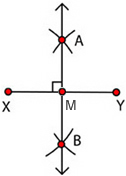 |
| Given a point on a line, how would you construct a line perpendicular to the given line that passes through the given point? | ||
|---|---|---|
| 1. | Begin with a given line k that contains point P. |  |
| 2. | Place the compass on point P. Using any radius, draw arcs intersecting line k at two points. Label the intersection points X and Y. |  |
| 3. | Place the compass at point X. Adjust the compass radius so that it is more than half of XY. Draw an arc as shown here. |  |
| 4. | Without changing the compass radius, place the compass on point Y. Draw an arc intersecting the previously drawn arc. Label the intersection point A. |  |
| 5. | Use the straight edge to draw line AP. Line AP is perpendicular to line k. | 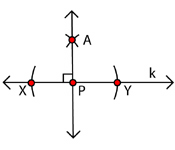 |
| Given an angle, how would you construct the bisector of that angle? | ||
|---|---|---|
| 1. | Let point P be the vertex of the given angle. Place the compass on point P and draw an arc across both sides of the angle. Label the intersection points Q and R. | 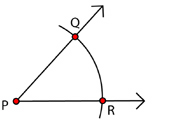 |
| 2. | Place compass on point Q, measure distance QR, and from the point Q using that distance draw an arc on the interior of the angle QPR. | 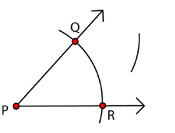 |
| 3. | Without changing the radius of the compass, place it on point R and draw an arc intersecting the one drawn in the previous step. Label the intersection point W. | 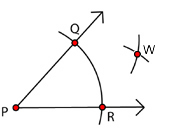 |
| 4. | Using the straight edge, draw ray PW. This is the bisector of ∠QPR. | 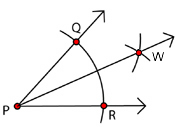 |
| Given a line segment, how would you construct an equilateral triangle with sides congruent to the given line segment? | ||
|---|---|---|
| 1. | Begin with line segment TU. |  |
| 2. | Center the compass at point T, and set the compass radius to TU. Draw an arc as shown. | 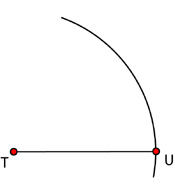 |
| 3. | Keeping the same radius, center the compass at point U and draw another arc intersecting the first one. Let point V be the point of intersection of the two arcs. | 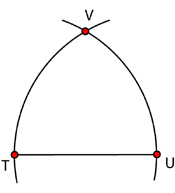 |
| 4. | Draw line segments TV and UV. Triangle TUV is an equilateral triangle. | 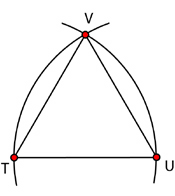 |
| Given a line and a point not on the line, how would you construct a line parallel to the given line through the given point? | ||
|---|---|---|
| 1. | Begin with the givens, point P and line k. |  |
| 2. | Draw any line through point P, intersecting line k. Call the intersection point Q. Now we’ll construct an angle with vertex P, congruent to the angle of intersection. | 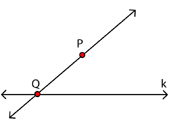 |
| 3. | Center the compass at point Q and draw an arc intersecting both lines. Without changing the radius of the compass, center it at point P and draw another arc. | 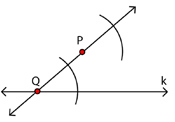 |
| 4. | Set the compass radius to the distance between the two intersection points of the first arc. Now center the compass at the point where the second arc intersects line PQ. Mark the arc intersection point R. |  |
| 5. | Line PR is parallel to line k. |  |
| How would you construct a triangle from three given line segments? | ||
|---|---|---|
| 1. | Begin with the givens, segments BC, AC, and AB. | |
| 2. | Draw a segment AX longer than any of the given segments. | |
| 3. | Set the compass radius to the length of segment AB, the longest segment. Center the compass at point A and draw an arc that intersects segment AX. Mark the intersection point B. | |
| 4. | Set the compass radius to the length of segment AC. Center the compass at point A and draw an arc that intersects segment AX. | |
| 5. | Set the compass radius to the length of segment BC. Center the compass at point B and draw an arc that intersects segment AX twice. Mark the intersection of this arc and the arc that was constructed in step 4 point C. | |
| 6. | Construct triangle ABC. | |